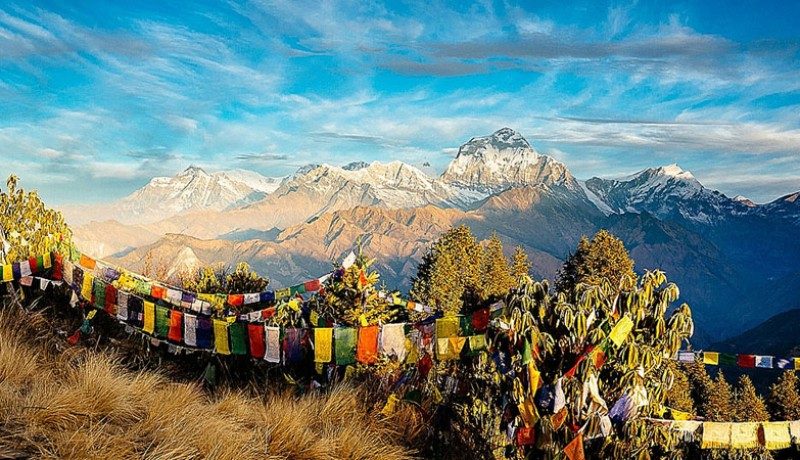
Annapurna Base Camp Poon Hill Trekking 12 Days
Tour Gallery
Overview
Annapurna Base Camp Poon Hill Trekking
Annapurna Base Camp Via Poon Hill gives beautiful views of the mountains during the trek.
Relaxing time in Pokhara and a hot spring bath on the trail
A trip that defines four types of climate and vegetation within a few kilometers of range.
This Annapurna Base Camp Poon Hill Trekking is 12 days (ABC) Trek is a luscious mix of remarkable mountain vistas, traditional mountain village life, thick rhododendron, and bamboo forest ecosystems.
Starting in the quaint lakeside town of Pokhara, the trail heads to Tikkhedunga and Ghorepani and continues through lush forests. Farmland to narrow gorges overlooked by the mighty Hiunchuli and Machapuchchre (Fishtail Mountain).
However, the Annapurna Base Camp PoonHill Trekking trail takes you to the heart of the Gurung and Magar cultures and their traditional way of life. It introduces you to a vast variety of birds and wildlife. At the same time, we are offering you the most magnificent views of the snow-capped mountains of the Annapurna Range.
Why is Annapurna Base Camp Poonhill Trek so popular?
Therefore, The Annapurna Base Camp Trek (ABC) is also the Annapurna Sanctuary Trek and one of Nepal’s most famous short and medium-length treks. Annapurna trekking region in Nepal is widely recognized as a naturalist’s paradise.
Also, the Annapurna trekking/tour region is a famous dramatic place for trekkers worldwide. One can do 4 to 21 days of trekking/tour in the Annapurna region. The upper sub-alpine steppe environment harbors some rare snow leopards and blue sheep.
Other areas of the Annapurna trekking region protect bird species, such as the multi-colored Impeyan, koala, and blood pheasant, among many other birds, butterflies, and insects. Many plants native to Nepal are found in the forest of the Annapurna trekking region.
The Annapurna conservation area has 100 varieties of orchids and some of the richest temperate rhododendron forests in the world.
However, Our destination is ABC, where a mountainous wonderland will encapsulate us surrounded by the icy peaks of some of the world’s highest and most beautiful mountains.
There are challenging days to meet our 4130-meter elevation goal, from rocky trails to the ascent of 3300 stone steps to Ulleri. All will be worth the effort as you accompany these majestic mountains to ABC over various exciting landscapes.
Descending from ABC, you can bathe in the natural hot spring at Jhinu before returning to Pokhara with your adventures and achievements in the Annapurna Himalayas in your heart.
In Conclusion, If you have a short period, you can trek at Annapurna Base camp – for 9 Days. Annapurna Region also offers Annapurna Circuit Trek with Tilicho Lake – 15 Days for well-experienced Trekkers.
Trip Highlights
- ☞Annapurna means “full of food,” significant to Hindus as the “Goddess of Harvest.”
- ☞Annapurna-I is the tenth-highest mountain in the world at 8,091 meters.
- ☞Annapurna was the first eight thousand ever to be climbed in 1950.
- ☞The renowned Tilicho Lake lies in the Annapurna Region.
- ☞The successful climbing ratio of Annapurna is only 38%, making it the most dangerous 8000ar to climb.
What's Included
Included Services
- ✓Airport picks up & drop by private vehicle to hotel.
- ✓Transportation from Kathmandu to Pokhara and Pokhara to Kathmandu vai Tourist bus.
- ✓Necessary paperwork and Trekking Permits fee.
- ✓Accommodation during trek and Meal (Breakfast, Lunch, Dinner and a cup of coffee or tea)
- ✓Licensed English or Chinese or Korean or Hindi along with Nepali speaking Friendly trekking guide.
- ✓Coverage of Guides including their Meals, Insurance, Salary, Lodging, transportation and other necessary equipment.
- ✓First Aid Medical Kit (Carried by the guide).
- ✓Sleeping bag, down jackets and trekking map, if necessary.
- ✓Emergency Evacuation Assistance Service (The cost of the helicopter, hospital and necessary transport are not payable by the company).
- ✓Welcome or farewell dinner in Kathmandu at a cultural restaurant (complimentary).
- ✓A nation-wide operated Mobile SIM Card and a map of the trekking region.
- ✓Porter (We can arrange porter for your trek).
- ✓Private vehicle from Kathmandu to Pokhara and Pokhara to Kathmandu.
Optional Addons
Excluded Services
- ✗International airfare.
- ✗Nepal Entry Visa fee: you can obtain a visa easily upon your arrival at Tribhuwan International Airport.
- ✗Personal Travel insurance which has to cover emergency high-altitude rescue and evacuation compulsory.
- ✗Personal expense (shopping, snacks, boil bottle water, hot and cold drinks, hot shower, Alcohol, Wi-Fi, telephone call, battery re-chargefee).
- ✗Accommodation, Lunches and dinners in Kathmandu, except the farewell dinner.
- ✗Emergency expenses such as expenses on charted helicopter.
- ✗Additional costs or delays caused by out of management control, for example, landslide, weather condition, itinerary modification due to safety concerns, illness, change of government policies etc.
- ✗Gratitude and tips for your guide, porter and driver.
Detailed Itinerary
More Information
Permits ABC Travel itinerary Cost & Highlights
Firstly you will be requiring a TIMS( Trekkers Information Management System) card wherever you trek. This card will come to you at a cost of about 20 USD for solo trekkers, and 10 USD for group trekkers.
For trekking the Annapurna Base Camp and Poon Hill 12 Days you will be requiring a special ACAP permit(Annapurna Conservation Area Project). This will cost you around 30 USD.
What is the highest elevation reached during the Annapurna Base Camp Poon Hill trek?
When talking about the absolute peak, will occur the moment you step foot in the Annapurna Base Camp at an altitude of 4130 meters(13,550 feet). During 12 Days Annapurna Base Camp Poon Hill Trek you also get to the top of Poon Hill at a settling altitude of 3,210 meters (10,531 feet). These attitudes are by no means to be taken lightly, trek safely following the necessary health protocols.
What kind of physical fitness is required to complete the Annapurna Base Camp Poon Hill trek?
A bit harder than you expected it to be. Since you need to be covering two major sites. The Annapurna Base Camp and the Poon Hill, of them, are a separate trek when talking. But 12 Days Annapurna Base Cam Poon Hill Trek is designed, to sum up, both of those great experiences together.
Moreover, it is important to have good cardiovascular fitness and endurance, as well as the ability to hike for several hours each day while carrying a light backpack. It is recommended to engage in regular physical activity and exercise before embarking on the trek.
What is the difficulty level of the trek compared to other treks in the Annapurna region?
The Annapurna Base Camp Poon Hill trek 12 Days is considered to be a moderate trek compared to other treks in the Annapurna region. The trek involves several days of hiking at high altitudes, with some steep ascents and descents, but the overall difficulty level is considered to be moderate.
What is the best way to acclimate to the high altitude during the Annapurna Base Camp Poon Hill trek?
At such an altitude what prevails the most and haunts people is Altitude sickness. One of the great aspects of the Annapurna Base Camp Poon Hill trek is Acclimatization. This trek involves reaching high elevations in a relatively short span of time. The best way to acclimate is to take it slow, with plenty of rest days and short hikes to allow the body to adjust to the changing altitude. Drinking plenty of water and avoiding alcohol and other dehydrating substances is also important.
In such a remote area, getting proper medical care is not guaranteed. Moreover, we suggest you that do a prior checkup and consult your doctor before trekking this trek.
What is the impact of the trek on the local communities and how can trekkers support sustainable tourism practices?
The Annapurna Base Camp Poon Hill trek is a popular tourist destination and can have both positive and negative impacts on the local communities. It is important for trekkers to be mindful of the impact they have and support sustainable tourism practices to minimize negative impacts and promote the conservation of the local environment and culture.
This can include using local guides, staying in local homestays, and supporting local businesses by buying locally sourced products. Additionally, trekkers can help by following the Leave No Trace principles, such as properly disposing of waste and minimizing the use of single-use plastics.



